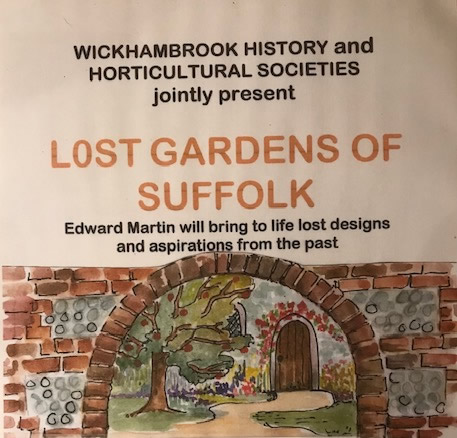Wickhambrook News October 2022
Wickhambrook Local History Society and Wickhambrook Horticultural Society held a joint meeting in October. The speaker, Edward Martin, an archaeologist, talked on The Lost Gardens of Suffolk. It was very interesting to see many historic houses of the county as they were in their heyday, with maps and plans and also to appreciate the changing fashions in gardening.
The earliest example was Clare Castle, where in the 14thC Lady Elizabeth de Burgh created a garden with a fountain, ornamental birds and a sepulchre copied from the Holy Sepulchre in Jerusalem. Her accounts show that she employed a carpenter and that sand and stones were moved to clear the ground. All of this was obliterated when the railway was built in 1863.
At Westhorpe Hall in 1525 a garden was made by Charles Brandon, Duke of Suffolk and his wife Mary, sister of Henry VIII. It was a ‘fair garden’ with an orchard and a bridge over the river. Terracotta plaques from the bridge can be seen in the V&A.
A survey of Shelley Hall in Hadleigh in 1519 shows a moat, fishponds and a garden A reconstruction of this Tudor garden was attempted in a television programme in 1999 although without the dovecote centrepiece.
Mettingham Hall records from 1562 mention an orchard, arbours and many small gardens and at Melford Hall in 1621 there were green gravelly walks and fruits of all kinds as well as a banquetting hall.
A very detailed map of Somerleyton Hall shows the garden becoming a place to show off to visitors. It had a fir tree plantation which was very unusual as evergreen trees were much admired for ‘bringing summer to winter’. Walks and viewing mounds were added.
When Charles II constructed a canal at Hampton Court, this became the latest ‘must have’ for owners of large houses and we were shown existing canals at Euston Hall, Little Thurlow and Campsea Ashe.
At Wangford Hall, near Brandon, the owners asked Gertrude Jekyll to design a plan for their garden. The plans and planting scheme still exist. The cost was £12. All of it now lies under the airfield at Lakenheath.
At Gifford’s Hall in Wickhambrook, Dulcie Smith re-created a Tudor Garden to match the house. Many of the audience could remember the wooden posts with heraldic beasts, the winding paths and woad plants. It has all disappeared.
We were surprised and pleased to learn that Humphrey Repton, one of the most famous garden designers ever, was born in Bury St Edmunds and his parents were married in Wickhambrook in 1739.
All the gardeners and historians in the audience thoroughly enjoyed this fusion of history and gardening and Edward Martin was warmly thanked for his interesting presentation.
